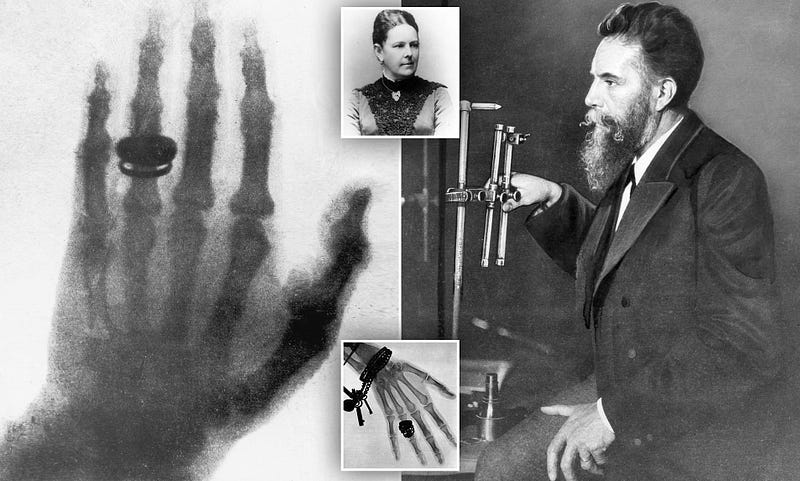The Unintentional Breakthrough: X-Rays and Their Impact
Written on
Chapter 1: The Accidental Discovery of X-Rays
In the realm of significant scientific discoveries, one of the most remarkable occurred due to an unexpected incident involving glass tubes. During the late 1800s, a German physics professor was conducting experiments with electric currents and glass tubes, aiming to generate rays of light. To eliminate any external light interference, he wrapped the tubes in black paper. To his astonishment, he observed an unusual green luminescence on a nearby screen. Driven by curiosity, he investigated further. This professor, Wilhelm Röntgen, soon realized that the glow emanated from a form of radiation that was penetrating through the paper and other materials. Unaware of its true properties, he named it “X-rays”.

Röntgen proceeded to experiment with various substances, including metals, wood, and even his own hands. He was astonished to find that he could visualize the bones within his own hand on a photographic plate. Overwhelmed by this discovery, he felt compelled to share his findings with the scientific community. He meticulously documented his research in a report and submitted it to various journals and fellow scientists. Along with his report, he included several X-ray images, one of which famously depicted his wife's hand adorned with her wedding ring.
The image sparked a mix of fear and fascination among the public, quickly spreading through media. Many viewed it as eerie or even reminiscent of dark sorcery. Some speculated that X-rays could unveil thoughts or invade privacy, while others feared potential harm or mortality. Yet, despite the trepidation, the phenomenon ignited curiosity and intrigue, prompting many to explore its possible applications. Soon, X-rays became integral to both scientific and medical fields, paving new paths for understanding matter and the human body.
With the ability to visualize internal structures without the need for surgery, X-rays greatly aided physicians in diagnosing and treating various ailments. Their utility extended beyond medicine, finding applications in industries, security, and even art, thus becoming an essential tool for enhancing our understanding of the world.
X-rays stand as one of the pivotal discoveries of the 19th century, fundamentally altering the trajectory of human history. This fortunate accident, born of curiosity and serendipity, was not a planned endeavor by Röntgen; rather, it emerged as he pursued other scientific inquiries.
In reflecting upon his groundbreaking work, Röntgen remained humble and generous, refraining from seeking patents or personal gain. His sole ambition was to share his enthusiasm and knowledge with others. In recognition of his monumental contributions, Röntgen was awarded the inaugural Nobel Prize in Physics in 1901.

The next time you undergo an X-ray at a hospital or dental office, remember that this remarkable tool stems from a curious individual experimenting with glass tubes who noticed something extraordinary.
Chapter 2: The Legacy of X-Rays
Exploring the life of Wilhelm Conrad Röntgen and his pivotal role in the discovery of X-rays, this video provides insights into the significance of this landmark achievement.
This video outlines the historical journey of X-rays, tracing their evolution in medical technology and their transformative impact on diagnostics and treatment.